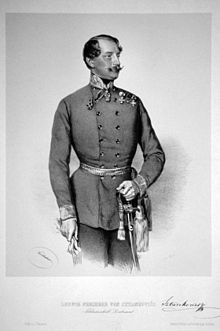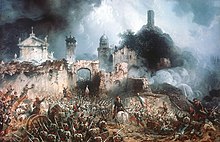Ludwig von Sztankovics
Ludwig Freiherr von Sztankovics , also Stankovics , (born August 21, 1805 in Edelény , Borsod county ; † April 17, 1868 in Vienna ), was an Imperial and Royal Privy Councilor , Feldzeugmeister , 2nd owner of Infantry Regiment No. 66 and Theresa Knight with Croatian Family roots.
Origin and family
Ludwig he came from a family ennobled by Emperor Leopold I , who originally called themselves Tankovich. His father, Andreas von Sztankovics, received the hereditary Hungarian knighthood from Emperor Franz I on November 16, 1827 as Rittmeister and squadron commander in the hussar regiment Archduke Ferdinand No. 3 for his services, especially for bravery in front of the enemy .
The general married Carolina von Rößler in 1835 and had two sons. Both became officers too. The elder Ludwig († June 29, 1859 in Verona ) died as a captain and bearer of the Order of the Iron Crown 3rd class as a result of his wounds, suffered in the battle of Solferino . The younger, Karl Ludwig (* October 13, 1836 - July 19, 1907), was appointed Lieutenant Field Marshal on October 26, 1892 and retired as Feldzeugmeister ad honores on April 1, 1898.
Life
Sztankovics joined the Hussar Regiment Archduke Ferdinand No. 3 as a cadet on August 1, 1820, was promoted to lieutenant on April 1, 1821 and first lieutenant on December 16, 1827 , while being appointed divisional and proprietor adjutant to Field Marshal Lieutenant Friedrich Karl Baron von Langenau , and on November 16, 1831 to lieutenant captain. In this function he was transferred to Line Infantry Regiment No. 49 in Mainz in 1833 . His military ascent continued rapidly: on December 1, 1837, he was promoted to captain , now with the infantry, and then to major on April 7, 1842 , where he was assigned to the Line Infantry Regiment Graf Leiningen-Westerburg No. 31 on June 1, 1847, he was promoted to lieutenant colonel . In that year he was appointed as the commander of a mobile column composed of various troops to pacify the revolting towns in the Sandsau and Wadowice districts, where he developed a great deal of insight and activity.
In Hungary
When relieving Arad under the command of field marshal lieutenant Count von Leiningen during the Hungarian uprising , he bribed on December 14, 1848, where he stormed the barricades as battalion commander at the head of his soldiers and conquered the areas of New Arad. For this act he was promoted to Colonel and Regiment Commander of Infantry Regiment No. 31 by the highest resolution dated December 14th and in addition to the rank tour and was decorated with the Order of the Iron Crown, Second Class with War Decoration (KD.).
In the fierce battles that took place in and near Arad from February 8 to 13, 1849, in his capacity as Quartermaster General of the Field Marshal Lieutenant Glasses, he developed military acumen and personal bravery, so that the military successes were largely due to his efforts. For this he advanced to the colonel and was decorated with the Order of the Iron Crown, second class, with the war decoration (KD.).

At the time of the defense of Timişoara, Sztankovics was entrusted with the management of the affairs of a chief of the Quartermaster General. In a short time he succeeded in supplementing the fortress' provisions to three months, increasing the garrison by 4494 recruits and bringing the garrison to 8659 men. During the 107-day distress, General and fortress commander Freiherr Georg von Rukavina entrusted him with the tactical management of the defense, and when the artillery director and later the genius director became incapacitated, these branches also merged in his hand. Wherever decisive precautions were to be taken, one saw him calmly and undeterred giving the orders of the fortress commander, and where there was imminent danger, taking the appropriate measures on the spot. He personally led the numerous failures and was a role model for his subordinates. For this he was awarded the Knight's Cross of the Maria Theresa Order (157th doctorate from March 26, 1850) as well as the Imperial Russian Order of Saint Anna 2nd class with crown and sword and that of Saint Vladimir 4th class with swords. According to the statute of the order, he was raised to the status of Austrian baron on June 21, 1850.
After the siege, Sztankovics led the 31st Infantry Regiment to Sibiu in Transylvania , where he then served as President of the Puritization and Court Martial, and on June 23, 1850 was promoted to Major General and Brigadier in the 1st Army Corps. In 1852 he was sent by the Kaiser to St. Petersburg and Moscow in military matters together with generals Heinrich Freiherr von Hess , Franz Freiherr von Hauslab and others, and on this occasion received the Order of St. Stanislaus, 1st class. At a troop revue in 1853, in the presence of the King of Prussia, he was awarded the Royal Prussian Order of the Red Eagle 2nd class with the star.
In Italy
On April 3, 1858, the officer was promoted to field marshal lieutenant and troop division in Milan . In the Italian campaign of 1859 he was appointed the first adjutant general of Feldzeugmeister Franz Joseph Graf von Gyulay and found in the battle of Magenta the opportunity to distinguish himself personally through prudence and bravery, for which he was awarded the Commander's Cross of the Leopold Order. After a change in army command, he received a troop division with the l. Army Corps and commanded them in the Battle of Solferino . After the peace agreement, the Freiherr division general in Verona remained with the 5th Army Corps and soon after became troop commander in Tyrol .
Appointed 2nd owner of Infantry Regiment No. 66 on January 16, 1860, shortly thereafter he was appointed Commander of the Mantua Fortress . On November 21, 1861, Emperor Franz Joseph I granted him the real privy council dignity tax-free. Finally, the general took part in the campaign in Italy in 1866, where he was awarded the Military Merit Cross with War Decoration (KD.) For his services. The King of Italy decorated him with the Commander's Cross of the Order of Mauritius and Lazarus for the correct handover of the Mantua fortress as a result of the Austro-Prussian War . On October 7, 1866, the meritorious officer was honored with the title of Feldzeugmeister ad honores and was given his well-deserved retirement.
The honorary citizen of Timişoara and honorary member of the Società Virgiliana for the arts and sciences in Mantua succumbed to a stroke at the age of 62 in his domicile in Vienna, where he lived in seclusion with his wife.
Awards
The officer has received many awards, including the:
- Knight's Cross of the Military Maria Theresa Order , 1850
- Imperial Austrian Order of the Iron Crown 2nd Class with the War Decoration (KD.) , 1849
- Commander's Cross of the Imperial Austrian Leopold Order , 1859
- Military Merit Cross of Emperor Franz Joseph I with the war decoration (KD.) , 1866
- Royal Prussian Order of the Red Eagle 2nd class with the star , 1853
- Imperial Russian Order of Saint Stanislaus 1st Class , 1852
- Imperial Russian Order of St. Anna 2nd Class with Crown and Sword , 1849
- Imperial Russian Order of Saint Vladimir 4th Class with Swords , 1849
- Commander of the Order of Mauritius and Lazarus , 1866
- Service badge for officers, 1st class
coat of arms
1850: Shield divided by red and black with a narrow, undulating silver right sloping bar diagonally to the right. In the upper red field is a saber that is turned upwards obliquely to the right, with a golden vessel, accompanied by three golden stars, one and two lined up obliquely to the right. In the lower black field a gold crowned golden lion with a knocked out red tongue appears. On the main edge of the shield rests the baronial crown and on top of it a gold-crowned tournament helmet set in its sights. From the crown of the helmet grows a lion similar to the one marked on the shield. The helmet covers are tinged black with gold on the right, red with silver on the left.
literature
- Karl von Blazeković: Chronicle of the kk 31st Line Infantry Regiment, currently Grand Duke Friedrich Wilhelm of Mecklenburg-Strelitz. KK Hof- und Staatsdruckerei, Vienna 1867, p. 93
- Jaromir Hirtenfeld : Austrian Military Calendar. VII. Year, volume 2, Verlag der Buchhandlung für Militärliteratur Karl Prohaska, Vienna 1857, p. 1713 ff.
- Streffleur's military magazine, issue 1, p. 367 f. obituary
Individual evidence
- ↑ a b c Valentin von Streffleur (ed.): "Austrian military magazine", X. Jg., 1st volume, Verlag der Redaction, Singerstraße 16, printed by R. von Waldheim, Vienna 1869, p. 367 ff. ( Nekrolog) digitized
- ↑ Military newspaper No. 55, of Wednesday, July 13, 1859, XII. Volume, p. 464
- ↑ a b Wiener Zeitung No. 96, from Wednesday, April 22, 1868, p. 261
- ↑ Carinthia No. 13, of Saturday, June 18, 1859, vol. 49, p. 102
- ^ MTO Sztankovics
- ↑ Oesterreichischer Militärfreund No. 77, from Saturday, June 28, 1851, p. 307 f.
- ^ A b c Antonio Schmidt-Brentano: The kk or kuk Generalität 1816–1918, Austrian State Archives, Vienna 2007, p. 183
- ↑ K. k. Army Ordinance Gazette, No. 46 of November 24, 1861, kk Hof- und Staatsdruckerei, Vienna 1861, p. 177
- ↑ Military Schematism of the Austrian Empire, KK Hof- und Staatsdruckerei, Vienna, December 1859, p. 58
- ↑ Constantin von Wurzbach : Sztankovics, Ludwig Freiherr (father) . In: Biographisches Lexikon des Kaiserthums Oesterreich . 42nd part. Kaiserlich-Königliche Hof- und Staatsdruckerei, Vienna 1880, pp. 254–257 ( digitized version ).
| personal data | |
|---|---|
| SURNAME | Sztankovics, Ludwig von |
| ALTERNATIVE NAMES | Sztankovics, Ludwig Freiherr von; Stankovics, Ludwig Freiherr von (full name) |
| BRIEF DESCRIPTION | Austrian general (Feldzeugmeister) |
| DATE OF BIRTH | August 21, 1805 |
| PLACE OF BIRTH | Edelény , Borsod county |
| DATE OF DEATH | April 17, 1868 |
| Place of death | Vienna |






